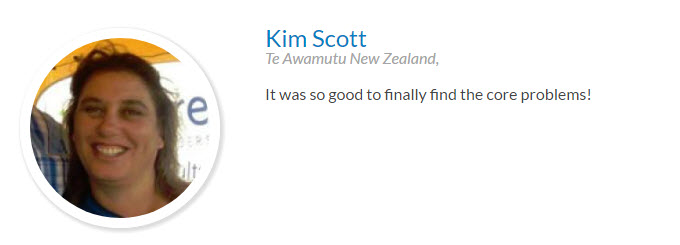
I'd like to tell you an amazing story about Kim and how she solved her two boys learning difficulties. It's one of those stories that when the answer came to her well, all she could thing was "Why didn't someone tell me this before"
The answer was so simple.
Kim lives in a very rural area near the very small town of Te Awamutu in New Zealand. It is a very rural farming district (But also the birthplace of Tim and Neil Finn of Crowded House. One of my favorite 80’s bands. Yeah!).

Kim’s boys struggled with all subjects.
- Reading
- Writing
- Spelling
- Math
Kim, being a determined mother, would do anything to fix that.
- She drove them to tutors.
- She drove them to specialists.
- She got extra help for them at school.
- She spent countless hours helping them with homework.
Living so remotely, all of this involved driving great distances. She spent a lot of time in the car and a lot of money. And of course all at the expense of taking time and resources away from running the farm.

A Stressed Out Mom? Not Anymore!
As with most Mothers of struggling learners, life was very hard for Kim.
And nothing was helping.
Her boys still struggled.
She felt she had done everything a mother could. She was frustrated to no end.
One night, Kim couldn't sleep. She was worried. And sitting up, with nothing else to do. She did an internet search. And she happened upon Learning Success. She started reading the site. She went through the analysis. She read my emails. But she didn't take me up on the offers to purchase right away.
Kim had tried everything. She was reluctant to purchase the system. She didn't want one more failure.
But finally, her mother’s instinct kicked in, and she made the choice to get the system. It was a fraction of the cost of anything else she had tried. So why not.
At that time the Learning Success System was very new. It was no more than daily emails that instructed her how to do the exercises. It did not have the fancy online portal it has today. It did not have the Learning Success staff helping parents out like they do now. It did not have the private facebook group. It did not even have the videos explaining how to do the exercises.
At that time it was a very basic version of what it is today.
Nevertheless, Kim purchased the program and followed the instructions.
Well, what happened next was pretty amazing.
You Want to Quit Why?
After about two months I got an email from Kim telling me she wanted to cancel the program. I was shocked. What could be wrong?
I asked Kim.
Me: "Was the program not satisfactory?"
Kim: "Oh no, that's not it. We loved it. It fixed the problem. I'm sure it has changed my boy's lives. We just don’t need it anymore because it worked. We're done!"
A sigh of relief…
Kim had followed the instructions. She had done the daily exercises. And, as expected, she started to notice that her boys had difficulty with a particular micro-skill. In this case the visual tracking exercises. So she worked the visual tracking exercises more and more.
Very soon her boys started improving.
They improved so much, and so fast that they no longer needed the program. They went from failing to great students. In just a few short months.
And the rest is history.

Key Takeaways:
Fantastic Grades In Just A Few Short Months, Wow!
Now, are those results typical?
Absolutely not.
It’s actually very unusual to have a problem with only one micro-skill. Happens occasionally, but usually, it’s a combination of two or three.
In Kim’s boy's case, it was a single micro-skill.
Visual tracking.
And visual tracking is usually the easiest and fastest to fix.
Maybe I should explain micro-skills a little better? Would that help?
Basically, they are the fundamental components of learning. And if one or more is weak, it will wreak havoc on learning.
You can think about micro-skills like ingredients in a recipe.
If I gave you:
- Flour
- Sugar
- Salt
What could you make?
Your choices would go something like:
- A tortilla
- Flatbread
- Paste
Maybe more.
So at least three possibilities out of just a few ingredients.
Add a few more ingredients, like maybe yeast, baking soda, or different flavors and the possibilities become endless.
Micro-skills are like that.
A combination of micro-skill weaknesses can manifest itself in a number of ways.
- Trouble with reading
- Trouble in math
- Trouble writing
- Trouble spelling
And almost always, difficulty in paying attention.
Trouble in learning then leads to emotional problems. All of that starts with just a minor micro-skill weakness.
On the other hand, if you build up the micro-skills, you build up learning ability. You actually make the mind stronger and faster. Every learning difficulty, whether it is dyslexia, dyscalculia, dysgraphia, or a whole host of other similar problems is simply a combination of micro-skill weaknesses. Something is just not processing correctly.
The good news is that micro-skills can be strengthened. Just like we can strengthen our body, we can also strengthen our mind. The new science of neuroplasticity tells us that brains can and do change. Given the right stimulus.
So back to my cooking analogy.
The point is, that even with the same ingredients, you can make a variety of things. Just like with micro-skills. A few weak micro-skills can manifest themselves as problems in a variety of areas. Reading, writing, math, or spelling. Or they can cause problems in just one area. There's no telling exactly where the problem will show. But no matter where it does, there is a solution.
But how do you know which one to work on?
Well, that's not as tricky as you would think. The normal assumption is that it would be best to diagnose exactly which micro-skill is the trouble spot and work specifically on that. A lot of people go down that path.
Seems logical right?
Except that it doesn't work.
Our brain is far more complex than that. Those micro-skills work together. And if you work them all together. In conjunction with one another. Mixing up and combining exercises. You get those micro-skills to work together better. And that's what you want.
Think about this.
You may not really pay attention to your mental processes when you read, spell, do math, or write. But, if you pay attention you might realize that:
- When you read, you use visual closure to recognize words.
- Visual memory to see the things those words relate to in your head.
- As well as, auditory discrimination and auditory memory to hear the words in your head.
When you do math, you use visual discrimination to discriminate between numbers and recognize amounts. Visual memory manipulation to combine them in your head. Visual tracking to line everything up on paper. And even auditory memory to help with the mental manipulations.
When you write, you use visual memory to visualize what you want to say. Auditory memory is more linear so you use that to organize thoughts. Then you use brain-eye-hand coordination to get it down on paper and visual tracking to keep it neat.
When you spell. If you are a good speller. You see the words in your head and simply read the letters out with auditory memory. If not you try to sound it out.
Now all of those examples are over simplifications. There's even more going on. But you get the point.
Even if one of those micro-skills is a problem. Or you are simply not in the habit of using it. There is going to be problems in one or more of the above academics.
How do you fix it?
Practice the micro-skills in combinations. As many combinations as possible.
That's why it's best not to try to exactly diagnose which is the trouble one, or two. It's better to work them all. Because the same weakness can manifest itself as a variety of problems.
If you work on them all, you will eventually see a pattern. At that point, you can do more of the trouble micro-skills, but not eliminate the others. That’s a much faster and much better approach than trying to “diagnose” the exact combination. And, well, it works. That's the way I do it. I'm kind of solution-oriented like that. I'd rather just do what works.
Action gets things done.
One of the other problems with "diagnosing" is this.
While it may be evident that there is a disconnect between auditory skills and visual skills, there is almost always a physical disconnect as well. I’ve never seen a child that had a learning difficulty that did not also have a proprioception issue. It may not have been readily apparent. Many were athletic and highly coordinated. But when I asked them to do bilateral coordination exercises the problem would show itself.
In other words, you have to treat the whole. Not diagnose a small part and treat only that. Include everything. Which also means the body, attitude, and emotions. Everything works together. The mind, the body, and the emotions. So it makes sense to exercise them all together. When we designed our micro-skill exercises we designed most of them so that they have a mix of skill-building. Auditory, visual, and kinesthetic. Some are specific to a skill. Others work several skills together. Variety and combining are essential.
But enough talk. How about we just try one out?
Today I want to give you a micro-skill exercise. You'll see how easy it is to do. How it is something you could easily do at home with your child. And I hope you can see how it will help. This exercise works on visual closure. Visual closure is our brain's ability to recognize an object or symbol without seeing the whole thing.
Why do we need this skill?
- For reading it allows us to recognize words without having to read them. This speeds up reading and improves comprehension because it takes the load off.
- For math, it helps us get math concepts because we can perceive amounts without counting. This speeds up math processing and makes it easier.
- For writing, it helps us put thoughts together and get them on paper. Helping both the thought processes behind writing and also the actual letter forming on the paper. Writing is actually very visual.
For spelling, it helps us “see” the words in our head and simply read what we see. Good spellers visualize the words. Bad spellers try to sound them out. So a problem in visual closure can be at least partially at fault in any academic problem.
This is a super easy lesson. You simply watch the video and call out the object as soon as you see it.
If you want to do it as a game, challenge someone to a duel with it. Or time the responses. Anyway you want to do it is fine. Just have fun with it. That’s part of the secret. Having fun.
Get the lesson here.
As parents we need to help our children navigate the learning process. The school systems are not always up to the task.
With a helpful guiding parent a child is sure to eventually "get it" and embark on the path to fantastic grades.
Do You Need help with a Learning Difficulty?
Our simple online analysis will help you get to the core of the problem and find the right solution for you.
Understanding how to help someone with a learning difficulty starts with understanding which micro-skills are affected. When you learn which of the micro-skills is the problem, you will then be on your way to solving it.
You'll also learn how to:
- Build confidence
- Enhance Learning ability
- Eliminate avoidance
- Build grit
You can get this analysis for free by filling out this simple form. This will help you get to the bottom of a learning difficulty and provide you with a solution. If you are ready to put this problem behind you click the button below and fill out the form.










